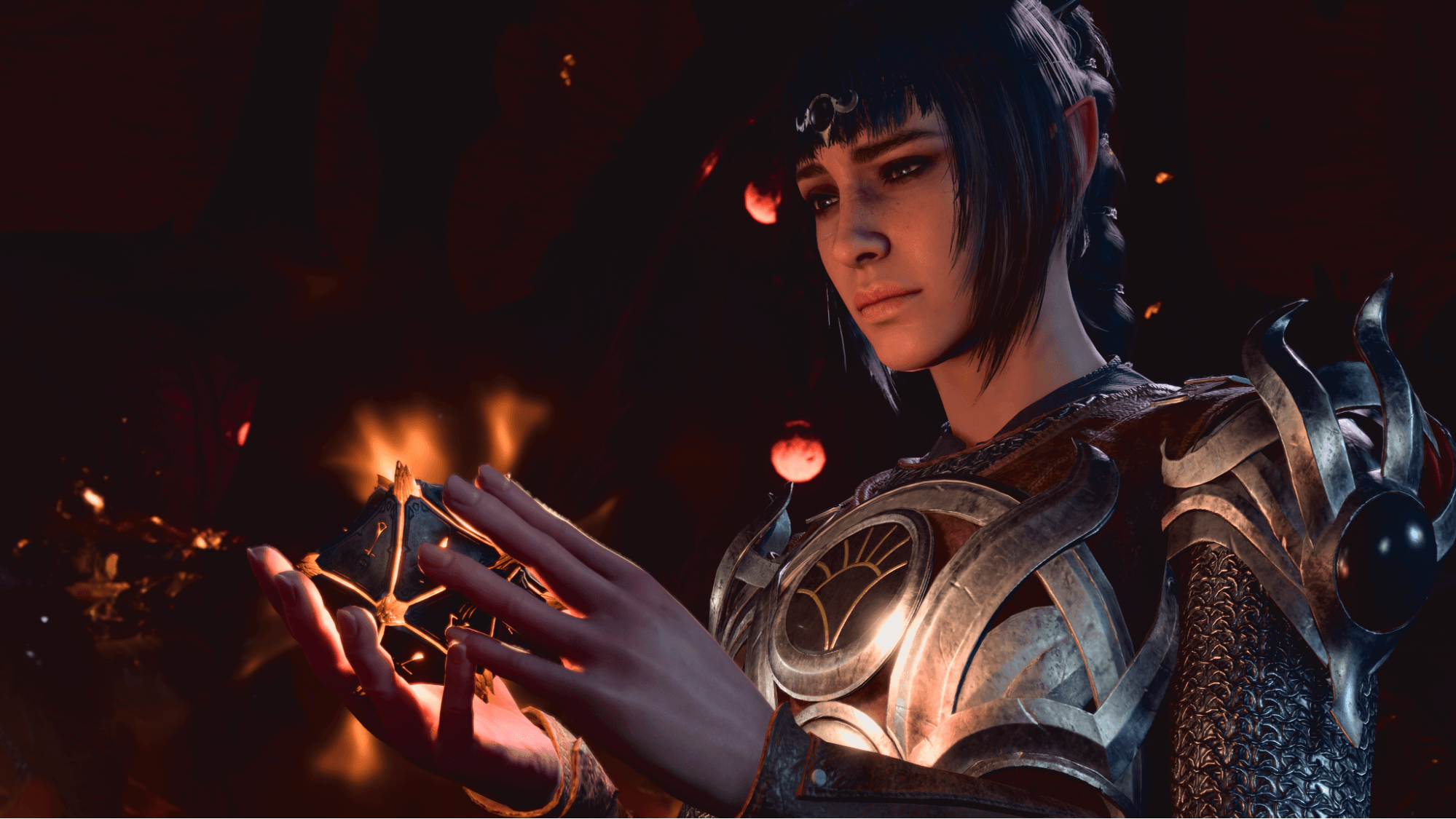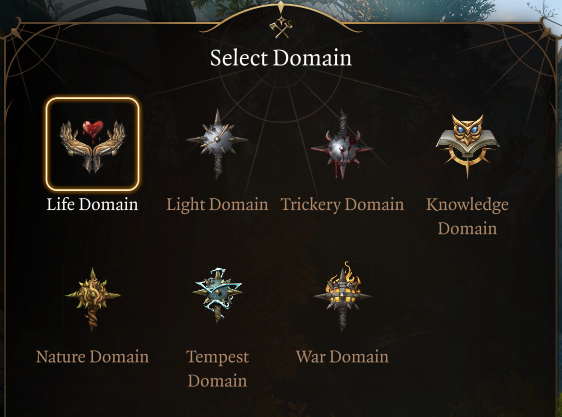Everything You Should Know About the Baldur’s Gate 3 Cleric and its Subclasses
Whether in the enemy’s face, or supporting the party from the back lines, Clerics are a Divine force to be reckoned with.
Wise, strong and versatile, this guide will take you through the pros and cons of the Cleric, as well as the unique play styles of every Domain they may devote themselves to.
Shadowheart may be this writer’s favorite Cleric, but whether you choose her or create your own, read on for all you need to know!
Find out where the Cleric ranks in our Baldur’s Gate 3 class tier list.
Pros and Cons
![]()
Pros
- As the name suggests, Clerics excel at being a primary healer and support for your party.
- Clerics can be played effectively in either melee or ranged builds, allowing more freedom in playstyles.
- Some subclasses allow you to wear Heavy Armor from the get-go, making for a very formidable self-sustaining frontliner.
Cons
- Due to the capability of being able to frequently Long Rest, Cleric does not have the same impact as it does in D&D 5E when it comes to keeping your party alive over long periods.
- Very few damaging spells force you to party up with more damage-centric classes, and severely limits your early-game capabilities.
- Many Cleric spells require Concentration (which can only have one active at a time)
Devoting their life to their chosen patron Deities, the Cleric is blessed with divine magic and charged with embodying the beliefs of the Gods they worship.
The diversity of Deities in Baldur’s Gate 3 lends to extensive roleplaying capabilities. Your choice of Deity will affect your relationship with certain NPCs as well as provide unique dialogue options in certain interactions with characters or the environment around you.
Clerics have a prime opportunity to align themselves on the classic alignment chart, reflected by the Deity and Domain they choose to follow. Below are the commonly accepted alignments of each Deity in Baldur’s Gate 3:
| Lawful Good: Bahamut Tyr Yondalla Ilmater Moradin Garl Glittergold |
Neutral Good: Mystra Lathander Mielikki |
Chaotic Good: Selune Corellon Larethian Eilistraee Tymora |
|---|---|---|
| Lawful Neutral: Helm Kelemvor |
True Neutral: Tempus Oghma |
Chaotic Neutral: |
| Lawful Evil Tiamat Laduguer Bane |
Neutral Evil Bhall Myrkul Shar Vlaakith |
Chaotic Evil
|
The Cleric’s main strength comes from their powerful supportive abilities, specifically in their healing capabilities.
When compared to Paladin, Clerics have many more play style options with their subclasses, but lack the impenetrable defensive capabilities that comes with Paladins, as well as the ability to communicate as effectively with CHR being one of Paladin’s main attributes.
Unlike Druids, Clerics excel at restoring and buffing allies, but lack the crowd control capability that is provided by the Druid.
Seen as wise, and respected by their congregations, Clerics boast an unmatched Wisdom, and knowledge of Medicine, Insight, Survival, and Animal Handling. They can efficiently multiclass due to Wisdom being a shared attribute with Rangers, Monks and Druids.
Just because a Cleric can keep you alive, doesn’t always mean they fight for the side of Good. Clerics have the unique ability to fill many types of character archetypes you may wish to play; from a Duergar War Cleric who follows Laduguer, ruling over their worshippers with an iron fist – to a Human Light Cleric, upholding and preserving ancient knowledge shared by Mystra.
When a party member needs a heal, do you simply oblige to care for them – or make them beg?

Straight from character creation players are given the choice between seven subclasses, each acting as the Domain of worship for the Cleric. The choice of Domain is a drastic one, as it will determine your entire role on the battlefield.
This freedom of choice allows you to play Cleric in numerous different styles, suited to best fit your party, or simply whatever you find more enjoyable to play!
Cleric Subclasses (Domains)

There are seven subclasses for Clerics in Baldur’s Gate 3. Each subclass is flavored as a different Domain that the Cleric disciplines themself in.
Every Cleric gains unique abilities as they level up, such as Turn Undead and Divine Intervention. Each Domain provides a unique set of new spells for the Cleric to cast, and these spells are always considered prepared.
- Life Domain
- Light Domain
- Knowledge Domain
- Nature Domain
- Tempest Domain
- Trickery Domain
- War Domain
Life Domain
| Level | Features Gained |
|---|---|
| 1 | Heavy Armor Proficiency, Disciple of Life, Bless, Cure Wounds |
| 2 | Preserve Life |
| 3 | Lesser Restoration, Aid |
| 5 | Revivify, Beacon of Hope |
| 6 | Blessed Healer |
| 7 | Death Ward, Guardian of Faith |
| 8 | Divine Strike: Life |
| 9 | Mass Cure Wounds, Greater Restoration |
The Life Domain is an aspect of many good deities, offering spells that protect and restore the mind, body, and soul.
Life Domain Clerics excel at raw healing potential, wielding powerful restorative spells and status ailment curatives. With the ‘Disciple of Life’ feature, all healing spells restore an additional 2 + Spell Level hitpoints.
For the classic ‘healer’ role, who can keep their party alive no matter how dicey the situation gets, the Life domain is the way to go.
Light Domain
| Level | Features Gained |
|---|---|
| 1 | Light, Warding Flare, Faerie Fire, Burning Hands |
| 2 | Radiance of the Dawn |
| 3 | Flaming Sphere, Scorching Ray |
| 5 | Daylight, Fireball |
| 6 | Improved Warding Flare |
| 7 | Wall of Fire, Guardian of Faith |
| 8 | Potent Spellcasting |
| 9 | Flame Strike, Destructive Wave |
The Light Domain is offered by deities of justice, majesty, and primordial flame, providing spells that dispel darkness and harm the undead.
Clerics following the Light Domain gain devastating combative spells in their arsenal. The Light Domain is suitable for the Clerics who wish to take on more of an offensive approach, while still being able to support the party when necessary.
The ‘Warding Flare’ feature can be used as a reaction to impose a disadvantage to an attacker, potentially being the difference between life and death.
The Light Domain is a perfect balance between defense and offense, creating a very self-sustaining Cleric.
Knowledge Domain
| Level | Features Gained |
|---|---|
| 1 | Blessings of Knowledge, Command, Sleep |
| 2 | Knowledge of the Ages |
| 3 | Calm Emotions, Hold Person |
| 5 | Speak with Dead, Slow |
| 7 | Confusion, Otiluke’s Resilient Sphere |
| 8 | Potent Spellcasting |
| 9 | Dominate Person, Telekinesis |
Adaptable and adroit in all manner of languages and skills, your mind is an intellectual cup brimming with exquisite knowing. The Knowledge Domain provides the opportunity to gain a +2 bonus Skill Proficiency points into two of History, Nature, Religion, or Arcana.
So strong is the mind of the Knowledge Cleric that they may imprint their own commands into an opponent’s mind or even communicate with the dead.
Nature Domain
| Level | Features Gained |
|---|---|
| 1 | Heavy Armor Proficiency, Speak With Animals, Animal Friendship, Shillelagh, Acolyte of Nature |
| 2 | Charm Animals and Plants |
| 3 | Spike Growth, Barkskin |
| 5 | Plant Growth, Sleet Storm |
| 7 | Dominate Beast, Grasping Vine |
| 8 | Divine Strike: Elemental Fury |
| 9 | Insect Plague, Wall of Stone |
You embody the vast viridian power of the natural world, an avatar of the subtle divinity of fruitfall, avian migration, woodland silence, and the landslide’s roaring fury.
Immediately taking pages from the Druid class, the Nature Domain commands power over nature, beasts and the elements.
Nature Clerics have the ability to speak with animals, and even tame the wild beasts they may come across to fight for them.
A Cleric in the Nature Domain commands the earth itself, creating difficult terrain and conjuring obstacles and hazards to keep enemies at bay.
Tempest Domain
| Level | Features Gained |
|---|---|
| 1 | Martial Weapon Proficiency, Heavy Armor Proficiency, Thunderwave, Fog Cloud, Wrath of the Storm |
| 2 | Destructive Wrath |
| 3 | Shatter, Gust of Wind |
| 5 | Call Lightning, Sleet Storm |
| 6 | Thunderous Strike |
| 7 | Ice Storm, Freedom of Movement |
| 8 | Divine Strike: Tempest |
| 9 | Insect Plague, Destructive Wave |
Your faith has made you the very thunder that quakes the black firmament, the lightning coursing through the veins of a terrible storm.
Clerics in the Tempest Domain become the storm itself; excelling at ranged or melee combat being given the proficiency to wield martial weapons and heavy armor.
Strike back at attacking enemies with lightning using the ‘Wrath of the Storm’ feature. The ‘Destructive Wrath’ feature allows you to spend a Channel Divinity charge to inflict maximum damage on a successful Thunder or Lightning roll.
The Tempest Cleric quickly ramps up to become a very threatening source of damage.
Trickery Domain
| Level | Features Gained |
|---|---|
| 1 | Disguise Self, Charm Person, Blessing of the Trickster |
| 2 | Invoke Duplicity |
| 3 | Mirror Image, Pass Without Trace |
| 5 | Bestow Curse, Fear |
| 7 | Polymorph, Dimension Door |
| 8 | Divine Strike: Poison |
| 9 | Dominate Person, Seeming |
A Domain shared by wicked, chaotic, and mischievous deities alike, those who channel Trickery specialize in deception and illusion magic. For players wanting a play style focused more on illusions, subterfuge, and controlling effects, the Trickery Domain is the way to go.
Trickey Clerics learn an abundance of spells that help them swiftly move around the world and battlefield alike, all while wreaking havoc on the minds of the enemies, causing them to freeze with fear, or even turn on their own allies.
War Domain
| Level | Features Gained |
|---|---|
| 1 | Martial Weapon Proficiency, Heavy Armor Proficiency, Divine Favour, Shield of Faith, War Priest |
| 2 | Guided Strike |
| 3 | Magic Weapon, Spiritual Weapon |
| 5 | Spirit Guardians, Crusader’s Mantle |
| 6 | War God’s Blessing |
| 7 | Stoneskin, Freedom of Movement |
| 8 | Divine Strike: Warmaster |
| 9 | Flame Strike, Hold Monster |
Fortified by holy zeal, you brandish an arsenal of sacramental savagery to use against those you deem unrighteous.
The most “in-your-face” type of Cleric, the War Domain is granted strength from the Gods of combat. War Clerics are given proficiency in martial weapons and heavy armor.
War Clerics are also given the ‘War Priest’ feature, which allows them to expend charges (equal to WIS modifier) to gain an extra attack as a bonus action.
The War Domain focuses primarily on melee combat, granting the Cleric capabilities to buff nearby allies, augment their weapons, and grant themselves additional resistances on the frontlines.
So which Cleric subclass should you play?
If you want to maximize support and pump out healing, choose Life.
For a perfect balance of offense and defensive spellcasting, choose Light.
To play sneaky and manipulate your opponents, choose Trickery.
If you want to gain extra skills and command your enemy’s minds, choose Knowledge.
To command nature, and gain more crowd control, choose Nature.
If you want to command the storm, and become an offensive caster, choose Tempest.
To play as a beefy melee threat, choose War.
Finally, remember that you can easily respec your character any time for just 100g, so feel free to try out every Domain and see which works best for you!
 Download APP
Download APP